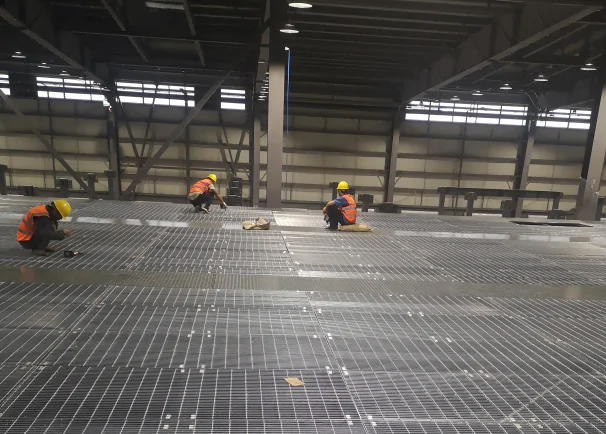Have you ever walked on a platform, bridge, or industrial site and felt the sturdy grip beneath your feet? That’s often the result of steel grating, a crucial component in many infrastructure projects. However, while it provides stability and safety for users, the installation process can pose risks if not done correctly.
Steel grating, with its versatility and durability, is a preferred choice for various applications ranging from industrial platforms to pedestrian walkways. Ensuring its safe installation is paramount, not just for the immediate workers but for the long-term users of the infrastructure.
By adhering to strict safety protocols during installation, we can guarantee that these structures remain reliable and secure. It’s essential to dive deep into these protocols, ensuring that every step taken is a step toward safety. Stick around as we delve into the best practices for installing steel grating safely, ensuring that every project is a testament to quality and safety.
Understanding Steel Grating

Definition and Primary Uses of Steel Grating
Steel grating is a framework of spaced bars that are either flat or serrated, positioned vertically and horizontally, and welded or locked together at the intersection points. This grid-like structure is designed to provide a slip-resistant surface that can bear heavy loads.
Its primary uses span across various industries, including construction, shipbuilding, and manufacturing. Due to its durability and strength, it’s commonly used in platforms, walkways, drainage covers, and stair treads, ensuring safety and allowing for the passage of light and air.
Common Types of Steel Grating and Their Specific Applications
There are several types of steel grating, each tailored for specific applications
| Welded Steel Grating | This is the most common type, where the intersection of the bearing bar and cross bar are welded together to provide strength. It’s widely used in most general industrial plants and commercial buildings. |
| Press-Locked Steel Grating | The bars are not welded but locked together. This type offers a smooth appearance and is often used in architectural applications. |
| Swage-locked Steel Grating | Known for its durability, this type locks cross bars into slots in bearing bars. It’s particularly useful in areas with heavy loads and high impacts, such as docks or airports. |
Pre-installation Safety Measures

A. Site Assessment
Before any installation begins, it’s crucial to evaluate the site. This involves identifying potential hazards, such as uneven ground, underground utilities, or overhead obstacles. A thorough assessment ensures that the ground or surface is stable and suitable for grating installation, preventing any future complications or risks.
B. Equipment and Material Inspection
Quality assurance is paramount. Before installation, the integrity and quality of steel grating panels must be checked. Any defects or inconsistencies can compromise the safety of the entire structure. Additionally, all installation tools and equipment, such as welding machines or fasteners, should be inspected to ensure they are in optimal working condition.
C. Personnel Training
The human element is as crucial as the materials used. Workers must be trained on safe installation procedures. This not only involves the technical aspects but also the potential risks and how to mitigate them. Regular refresher courses and safety drills ensure that safety remains a top priority and that all personnel are updated on the latest safety protocols.
Safe Installation Procedures

A. Proper Lifting Techniques
Steel grating panels can be heavy and cumbersome. Using mechanical aids like cranes or forklifts is essential to ensure safe lifting and transportation. However, if manual lifting is unavoidable, workers should be trained on safe handling techniques, such as bending at the knees and not the waist, to prevent injuries.
B. Securing the Grating
Once in place, the grating must be securely anchored and fastened. This ensures stability and longevity of the structure. Depending on the type of grating and its application, various fastening methods might be used. Regardless of the method, it’s vital to double-check all fastenings to ensure they are secure.
C. Working at Heights
Often, steel grating installation requires working at elevated heights. In such scenarios, using safety harnesses and other protective equipment is non-negotiable. Additionally, any scaffolding or platforms used should be inspected for stability and security, ensuring that workers have a safe environment to operate in.
Post-installation Safety Checks

A. Visual Inspection
After the installation process, a comprehensive visual inspection is crucial. This step ensures that no visible defects or issues have been overlooked during installation. It’s essential to check for any misalignments, gaps, or improperly fastened sections. Any discrepancies found should be addressed immediately to ensure the integrity of the grating.
B. Load Testing
To guarantee the steel grating’s safety and durability, load testing is imperative. This involves applying weight or force to the grating to ensure it can safely support the intended load. The testing should mimic real-world conditions as closely as possible to ensure the grating’s reliability under actual operational circumstances.
C. Maintenance and Regular Checks
Steel grating, like any infrastructure component, requires regular maintenance. Periodic inspections are essential to ensure the grating remains safe over time. These checks help identify and address any wear and tear or damage promptly, ensuring the grating’s longevity and safety.
Common Mistakes and How to Avoid Them
| A. Overloading the Grating | Avoid exceeding the grating’s weight limits to prevent deformation or failure. |
| B. Ignoring Signs of Wear or Damage | Don’t ignore early signs of grating wear. Regular inspections and prompt repairs ensure safety. |
| C. Neglecting Regular Maintenance | Consistent maintenance checks prevent potential issues, keeping the grating in top shape. |
Conclusion
The installation and maintenance of steel grating are not just technical tasks; they are commitments to safety and quality. As we’ve explored, numerous steps and precautions are essential to ensure the safe installation and longevity of steel grating. Industries must prioritize these safety protocols, understanding that they are not just guidelines but essential practices. By doing so, we not only ensure the safety of the workers involved in the installation process but also the countless individuals who will rely on these structures daily. Let’s champion safety, quality, and regular training, making every steel grating installation a benchmark of excellence.


